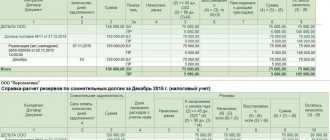Federal laws No. 401-FZ and No. 405-FZ dated November 30, 2016 amended Article 266 of the Tax Code of the Russian Federation, which regulates the procedure for creating reserves for doubtful debts. Starting from 2021, the amount of doubtful accounts receivable in relation to each counterparty should be determined minus accounts payable to this counterparty, and the maximum amount of the reserve at the end of the reporting period should be calculated as the greater of two values: 10% of revenue for the given reporting period or for the previous year *. 1C experts spoke about how these changes are supported in the 1C: Accounting 8 program (rev. 3.0), BUKH.1C.
Note:
* For other changes to income tax from 2021, read the article “Income Tax 2021: New in creating reserves for doubtful debts and carrying forward losses.”
The procedure for forming reserves for doubtful debts...
... in accounting
Provisions for doubtful debts are classified as valuation reserves. Valuation reserves in accounting take into account deviations in the valuation of assets (which includes receivables) and liabilities. Thanks to valuation reserves, financial statements are adjusted and thereby reflect the real financial condition of the organization.
The rules for recognizing and disclosing information about changes in estimated values in the financial statements of organizations are regulated by PBU 21/2008 “Changes in estimated values,” approved. by order of the Ministry of Finance of Russia dated October 6, 2008 No. 106n (hereinafter referred to as PBU 21/2008).
The procedure for forming reserves for doubtful debts is established by the Regulations on accounting and reporting in the Russian Federation, approved by Order of the Ministry of Finance of Russia dated July 29, 1998 No. 34n (hereinafter referred to as the Regulations).
In accordance with paragraph 70 of the Regulations, the organization creates reserves for doubtful debts in the event that receivables are recognized as doubtful. Thus, the creation of reserves for doubtful debts in accounting is an obligation, and not a right, for all organizations without exception. At the same time, when calculating reserves, it is necessary to take into account all debtors, including suppliers for advances issued and borrowers.
An organization's receivables are considered doubtful if they are not repaid or with a high degree of probability will not be repaid within the time limits established by the agreement and are not secured by appropriate guarantees. The amount of the reserve is determined separately for each doubtful debt, depending on the financial condition (solvency) of the debtor and the assessment of the likelihood of repaying the debt in whole or in part. Each organization determines the criterion for qualifying a specific debt as doubtful independently. To recognize a debt as doubtful, an organization must have supporting documents indicating the insolvency of the counterparty. This could be an extract from the Unified State Register of Legal Entities with information about possible liquidation, data from the debtor’s financial statements, information about arbitration awards with the participation of the counterparty, a statement about the commencement of bankruptcy proceedings, etc. Ultimately, the conclusion that a debt is classified as doubtful is based on the professional judgment of the accountant.
The reserve should be formed after the reconciliation and inventory of settlements with debtors has been carried out. Legislative and regulatory acts on accounting do not answer the question of how often reserves need to be created and adjusted, so the organization sets the frequency of creating reserves independently. In any case, reserves must be created no less frequently than the frequency of reporting for users.
The organization also determines the procedure for creating and using the reserve independently and enshrines it in its accounting policies.
For accounting of reserves, account 63 “Provisions for doubtful debts” is used. Analytical accounting is maintained for each doubtful debt. The creation of the reserve is reflected by an entry on the credit of account 63 in correspondence with account 91.02 “Other expenses”.
Since the amount of the reserve for doubtful debts is an estimate, this value may be changed due to the emergence of new information. Changes in the estimated value are subject to recognition in accounting by inclusion in the income or expenses of the organization. An increase in the reserve is reflected by an entry in the debit of account 91.02 and a credit of account 63, and a decrease is reflected by an entry in the debit of account 63 and the credit of account 91.01 “Other income”.
If by the end of the reporting year following the year the reserve was created, this reserve is not used in any part, then the unspent amounts are added to the financial results when drawing up the balance sheet at the end of the reporting year (paragraph 5, clause 70 of the Regulations). Unspent amounts of reserves are written off by recording the debit of account 63 and the credit of account 91.01. At the same time, based on the newly conducted inventory, if the debt continues to remain doubtful, a new reserve is created.
The balance of account 63 is not shown in the balance sheet, and the amount of accounts receivable for which the reserve is formed is reflected minus the amount of the reserve.
At the same time, retained earnings are reduced by the same amount (clause 35 of PBU 4/99 “Accounting statements of an organization,” approved by order of the Ministry of Finance of Russia dated July 6, 1999 No. 43n). Thus, users of reporting receive reliable information about receivables that can be collected.
As for the financial results statement, deductions to reserves for doubtful debts are reflected as part of other expenses (clause 11 of PBU 10/99 “Expenses of the organization,” approved by order of the Ministry of Finance of Russia dated May 6, 1999 No. 33n).
... in tax accounting
The purpose of creating this reserve in tax accounting is to be able to gradually and evenly account for the costs that arise due to the need to write off receivables that have not been repaid on time.
The procedure for forming reserves for doubtful debts for corporate profit tax purposes is regulated by Article 266 of the Tax Code of the Russian Federation. In accordance with paragraph 3 of this article, the creation of a reserve for doubtful debts is the right, and not the obligation, of the taxpayer, therefore the formation of reserves is determined by the accounting policy for tax purposes.
Doubtful debt for the purposes of forming reserves in tax accounting is recognized as the receivables of the counterparty in connection with the sale of goods, performance of work, provision of services, if this debt is not repaid within the time period established by the agreement and is not secured by a pledge, surety, or bank guarantee. In letter No. 03-03-06/2/150 dated September 29, 2011, the Russian Ministry of Finance clarifies that debts of suppliers (for the supply of goods (works, services) or for the return of an advance), debts of borrowers, and also are not recognized as doubtful debts in tax accounting. debts for payment of contractual sanctions and payment of transferred property rights (claims).
From 01/01/2017, the amount of doubtful accounts receivable in relation to each counterparty should be determined minus the accounts payable to this counterparty (clause 1 of Article 266 of the Tax Code of the Russian Federation as amended by Federal Law No. 401-FZ of November 30, 2016).
The amounts of reserves for doubtful debts are determined based on the results of the inventory of receivables carried out on the last day of the reporting (tax) period.
Taxpayers who pay advance payments based on actual profits calculate reserves at the end of each month, other taxpayers - at the end of each quarter (clause 3 of Article 266 of the Tax Code of the Russian Federation). Amounts of contributions to reserves are included in non-operating expenses (clause 7, clause 1, article 265).
The amount of the provision for doubtful debts depends on the duration of the doubtful debt. When determining the amount of the reserve, the following are taken into account (clause 4 of Article 266 of the Tax Code of the Russian Federation):
- 100% of the amount of doubtful debts with a period of occurrence exceeding 90 calendar days;
- 50% of the amount of doubtful debts with a period of occurrence from 45 to 90 calendar days (inclusive).
No provision is created for doubtful debts with a maturity of up to 45 days.
The period of occurrence is counted relative to the date on which the receivables are recognized as doubtful in accordance with paragraph 2 of Article 266 of the Tax Code of the Russian Federation.
When creating a reserve for doubtful debts, the taxpayer has the right to take into account the amount of doubtful debt in the amount presented by the seller to the buyer, including the amount of value added tax (letter of the Ministry of Finance of Russia dated July 24, 2013 No. 03-03-06/1/29315).
Unlike accounting, tax legislation establishes an additional limitation on the amount of the reserve. We remind you that for the purpose of rationing the reserve, revenue without VAT from the sale of goods, work, services, and property rights is taken into account (Article 249 of the Tax Code of the Russian Federation). As for non-operating income, they are not included in the calculation of the standard.
Starting from 2021, the procedure for calculating the maximum amount of the reserve for doubtful debts has been changed (Article 4, Article 266 of the Tax Code of the Russian Federation as amended by Federal Law No. 405-FZ of November 30, 2016, hereinafter referred to as Law No. 405-FZ). At the end of the year, as before, the maximum amount of the reserve cannot exceed 10% of the revenue for the specified tax period. But based on the results of the reporting periods, now you need to compare two values and select the largest of them:
- 10% of revenue for the previous tax period (for example, 2016);
- 10% of revenue for the current reporting period (for example, for the first quarter of 2021).
On the last day of the reporting (tax) period, the amount of the calculated reserve is compared with the amount of the balance of the reserve calculated as of the previous reporting date:
- if the amount of the reserve is less than the amount of the balance of the reserve, then the difference is subject to inclusion in non-operating income;
- if the amount of the reserve is greater than the amount of the balance of the reserve, then the difference must be included in non-operating expenses.
The balance of the reserve is understood as the difference between the amount of the reserve calculated as of the previous reporting date and the amount of bad debts that arose after the previous reporting date (clause 5 of Article 266 of the Tax Code of the Russian Federation as amended by Law No. 405-FZ).
If the organization does not make changes to its accounting policies for the next tax period regarding the formation of reserves for doubtful debts (i.e., continues to create them), then the unused amount of reserves is carried over to the next tax period.
If a reserve for the next period is not created, then the balance of the reserve is included in non-operating income (clause 7 of Article 250 of the Tax Code of the Russian Federation).
Due to differences in the rules for determining the amount of reserves in accounting and for profit tax purposes, differences in assessment may arise:
- reserves accounted for in account 63;
- income and expenses recorded in account 91;
- as a result - profits and losses recorded in account 99.
In accordance with the Accounting Regulations “Accounting for income tax calculations”, approved. by order of the Ministry of Finance of Russia dated November 19, 2002 No. 114n (hereinafter referred to as PBU 18/02), these differences are permanent. Permanent differences recorded in account 99 are taken into account when calculating income tax for the corresponding period: a permanent tax liability (PNO) or a permanent tax asset (PNA) is recognized.
Support for automatic calculation of reserves for doubtful debts in 1C: Accounting 8 (rev. 3.0)
In the 1C: Accounting 8 program, edition 3.0, the automatic calculation of reserves for doubtful debts is set to:
- in accounting - in the Accounting policy form (section Main -> Settings -> Accounting policy);
- for profit tax purposes - in the Taxes and Reports Settings form (Section Main -> Settings -> Taxes and Reports).
By default, the formation of provisions for doubtful debts in the program is disabled.
If reserves for doubtful debts are created in accounting, then in the Accounting policy form you need to set the flag Provisions for doubtful debts are formed.
If a reserve for doubtful debts is created in tax accounting, then in the Tax and Report Settings form in the Income Tax section, you need to set the Create reserves for doubtful debts flag.
If at least one of the specified flags is set, then the routine operation Calculation of reserves for doubtful debts will be included in the Month Closing processing. If there is no doubtful debt, then the document will still be created, but will not have any movements in the registers.
Doubtful debt for the purposes of automatic formation of a reserve in accounting and tax accounting in the program is considered to be outstanding debt reflected in accounts 62.01 “Settlements with buyers and customers” and 76.06 “Settlements with other buyers and customers”.
Please note that in the program reserves are formed only for contracts in rubles.
To calculate the period of occurrence of doubtful debts, the following indicators are used:
- The deadline for payment of debt by buyers, set in the accounting parameters settings (Fig. 1). Accounting parameters can be accessed via the hyperlink of the same name from the Administration section;
- The payment period under the agreement is established - in the form of an agreement with the counterparty (Fig. 2).
Rice. 1. Setting up accounting parameters
Rice. 2. Setting the payment deadline in the contract with the buyer
The date from which the period for the occurrence of doubtful debts is calculated in the program is determined as follows:
- if the agreement establishes a payment period, then the debt is considered doubtful if it is not repaid (in whole or in part) after a specified number of days, starting from the date the receivable arose;
- If the agreement does not specify a payment period, then a debt that is not repaid (in whole or in part) after the number of days specified in the accounting settings, starting from the date the receivable arose, is considered doubtful.
Please note that for the purposes of creating reserves for doubtful debts, the program does not check whether the receivables are truly doubtful (not secured by guarantees, collateral, etc.). You can set up such a check in the program indirectly through the value of the indicator The payment term has been set under the agreement in the agreement card with the counterparty. If the organization has received security for the debt from the buyer or it has confidence in its solvency, then to exclude this debt from the calculation of reserves for it, it is enough to indicate in this indicator a obviously long payment period (in calendar days).
The calculation and adjustment of the reserve for doubtful debts in accounting and tax accounting in the program is carried out using the routine operation Calculation of reserves for doubtful debts.
By default, the program suggests performing this routine operation monthly. Organizations that submit income tax returns once a quarter, in order to comply with the principle of rational accounting, can also calculate reserves once a quarter (in March, in June, in September and in December). To refuse to perform the routine operation Calculation of reserves for doubtful debts, before performing month closing in the first and second months of each quarter, select the Skip operation command in the context menu of the routine operation.
Regular operation Calculation of provisions for doubtful debts is carried out in two stages:
- doubtful accounts receivable are calculated. From 2021, if there are counter-obligations to the counterparty, in order to calculate the reserve, the receivables of the counterparty are reduced by the accounts payable to the counterparty. This change is supported in the program starting from version 3.0.46.19;
- reserves are calculated and entries are generated in the accounting register and entries in the information register. Calculation of reserves for doubtful debts. The amount of contributions to the reserve is calculated as a percentage of the debt amount depending on the duration of the delay (interval method), that is, according to the rules of tax accounting (clause 4 of Article 266 of the Tax Code of the Russian Federation). In tax accounting, the amount of the reserve is determined taking into account the limitation calculated by the regulatory operation Calculation of shares of write-off of indirect expenses.
When performing the routine operation Calculation of shares of write-off of indirect expenses, the amount of the reserve for doubtful debts is normalized, which can be accepted in tax accounting for income tax.
The maximum amount of the reserve at the end of the tax period is limited to 10% of the revenue of the reporting year. The maximum amount of the reserve at the end of the reporting period from 2021 is calculated as the greater of two values: 10% of revenue for the specified reporting period or for the previous year. This change is supported in the program starting from version 3.0.46.19.
In practice, this norm means the following: if the total amount of reserves calculated based on the period of debt occurrence exceeds the maximum amount, then the amount of the reserve for each debt, recognized as a non-operating expense, is normalized by multiplying by a coefficient. The coefficient is calculated as the ratio of the amount of reserves according to the standard to the total amount of reserves calculated based on the period of debt occurrence. The coefficient calculated in this way is entered into the indicator Reserves for debts of the information register Share of write-off of indirect expenses.
Determination of the maximum amount of reserves before and after 2017
Let's look at how "1C: Accounting 8" edition 3.0 reflects operations on the formation of reserves for doubtful debts, taking into account the latest changes in tax legislation.
Example 1
| The organization Perspektiva LLC (contractor) entered into an agreement with Delta LLC (customer) for the provision of services. The agreement establishes a payment period for services rendered - no later than 5 days from the date of signing the act of provision, applies the general taxation system, the provisions of PBU 18/02, and pays VAT. The accounting policy of Perspektiva LLC for profit tax purposes provides for the formation of reserves for doubtful debts. In both accounting and tax accounting, reserves are calculated at the end of each quarter. On November 2, 2015, services were provided to the customer in the amount of RUB 150,000. (including VAT 18%), the act was signed on the same day. Payment was not received from the buyer within the established period. Proceeds from sales of Perspektiva LLC, taken into account for profit tax purposes, amounted to:
|
Before starting work, the user must configure the accounting policies and tax accounting parameters. For the example under consideration, in the contract card with the customer, it is necessary to indicate the payment period under the contract, as shown in Figure 1.
To reflect sales transactions in the 1C:Accounting 8 program, edition 3.0, the standard accounting system document Sales (act, invoice) (Sales section) with the type of transaction Services is used.
In order for the buyer's debt to be automatically included in the calculation of reserves, in the Settlements form (accessed via the hyperlink of the same name from the sales document form), the Account of settlements with counterparty attribute must take the value 62.01 or 76.06.
As of November 30, 2015, doubtful debt amounts to RUB 150,000.00, but its period of occurrence does not exceed 45 calendar days. Therefore, the routine operation Calculation of reserves for doubtful debts for November does not make any movements in the registers. The indicator Provisions for debts in the information register of the Share of write-off of indirect expenses is also not calculated.
But as of December 31, 2015, the debt period is already in the range from 45 to 90 calendar days, therefore, when performing the operation Calculation of reserves for doubtful debts for December, the reserve is calculated and the accounting entry is generated:
Debit 91.02 Credit 63 - for the amount of the reserve, the value of which is RUB 75,000.00. (RUB 150,000.00 x 50%).
For tax accounting purposes for income tax, amounts are entered into special resources of the accounting register:
Amount NU Dt 91.02 and Amount NU Kt 63 - for the amount of the reserve, taking into account the limitation, the value of which is RUB 70,000.00. (700,000.00 x 10%); Amount PR Dt 91.02 and Amount PR Kt 63 - for a constant difference, the value of which is RUB 5,000.00. (RUB 75,000.00 – 70,000.00).
The document Regular transaction with the type of operation Calculation of reserves for doubtful debts, in addition to movements in accounting and tax accounting, also creates an entry in the periodic register of information Calculation of reserves for doubtful debts, reflecting information about doubtful debts and accrued reserves in accounting and for profit tax purposes.
To document the calculation of the accrual and adjustment of the reserve for doubtful debts, you need to generate a statement of calculation for the routine operation.
It can be done:
- from the context menu of the routine operation Calculation of provisions for doubtful debts;
- Click the Help-calculation button from the Month Closing processing form;
- from the Operations section -> Closing the period by clicking on the References-calculations hyperlink and selecting the Provisions for doubtful debts option.
The Certificate-Calculation of Provisions for Doubtful Debts report can be generated by separately displaying accounting indicators, tax accounting indicators or accounting indicators with permanent and temporary differences (Fig. 3). Indicators are selected in the report settings, which can be accessed by clicking the Show settings button.
Rice. 3. Certificates of calculations of reserves for doubtful debts
Please note that in the Certificate of calculation of reserves for doubtful debts according to tax accounting data, column 4 reflects the share of recognition of expenses taking into account the standard, which is calculated when performing the regulatory operation Calculation of shares of write-off of indirect expenses and is recorded in the indicator Provisions for debts of the information register Shares of write-off of indirect expenses.
When performing the routine operation Calculation of income tax for December, which is included in the Closing of the month processing, a permanent difference leads to the recognition of a permanent tax liability in the amount of RUB 1,000.00.
In the income tax return for 2015 (approved by order of the Federal Tax Service of Russia dated November 26, 2014 No. ММВ-7-3 / [email protected] ), the amount of contributions to the reserve (RUB 70,000.00) is reflected in the total amount of non-operating expenses for line 200 of Appendix No. 2 to Sheet 02.
2021 is coming. As of March 31, 2016, the debt period already exceeds 90 calendar days, so the amount of the reserve is determined as 100% of the amount of doubtful debt and amounts to RUB 150,000.00. This means that in accounting the reserve must be adjusted upward.
In tax accounting, the maximum amount of contributions to the reserve is already calculated based on 2021 revenue, therefore, the amount of the reserve, taking into account the limitation, should not exceed RUB 25,000.00. (RUB 250,000.00 x 10%).
The previously accrued reserve must be adjusted downwards, and the difference is included in non-operating income.
Thus, in the first quarter the tax base increases by the amount of the restored reserve.
When performing the operation Calculation of provisions for doubtful debts for March, the following accounting entry is generated:
Debit 91.02 Credit 63 – for the amount of the increase in the reserve (RUB 75,000.00 = RUB 150,000.00 – RUB 75,000.00).
For tax accounting purposes for income tax, amounts are entered into special resources of the accounting register:
Amount NU Dt 63 and Amount NU Kt 91.01 - for the amount of the restored reserve (45,000.00 rubles = 70,000.00 - 25,000.00 rubles); Amount PR Dt 91.02 and Amount PR Kt 63 - for a constant difference (RUB 75,000.00); Amount PR Dt 63 and Amount PR Kt 91.01 - for a negative constant difference (- 45,000.00 rub.).
When performing the routine operation Calculation of income tax for March, which is included in the Closing of the month processing, permanent differences lead to the recognition of a permanent tax liability in the amount of RUB 24,000.00.
Until the end of 2021, the amount of the reserve in accounting remains unchanged (RUB 150,000.00). In tax accounting, the reserve is adjusted upward on a quarterly basis as revenue increases.
When performing the operation Calculation of provisions for doubtful debts for December 2021, the following accounting entry is generated:
Debit 63 Credit 91.01 - for the unspent amount of the reserve created last year and added to income (RUB 75,000.00); Debit 91.02 Credit 63 - for the amount of the reserve added to expenses (RUB 75,000.00).
For the purposes of tax accounting for income tax, amounts are entered into special resources of the accounting register (the reserve is accrued up to the maximum amount, permanent differences are reflected).
Thus, as of December 31, 2021, after performing the operation Calculation of reserves for doubtful debts, the amount of the reserve is:
- RUB 150,000.00 — in accounting;
- RUB 100,000.00 (RUB 1,000,000.00 x 10%) - in tax accounting.
In the income tax return for 2021 (approved by order of the Federal Tax Service of Russia dated October 19, 2016 No. ММВ-7-3 / [email protected] ), reserves for doubtful debts are reflected as follows:
- the amount of restored reserves (45,000.00) is reflected in the total amount of non-operating income on line 100 of Appendix No. 1 to Sheet 02 of the declaration;
- the amount of contributions to the reserve (RUB 75,000.00) is reflected in the total amount of non-operating expenses on line 200 of Appendix No. 2 to Sheet 02.
With the onset of 2021, the procedure for calculating the maximum reserve amount in tax accounting is changing. Since there is no revenue in the first quarter of 2017, the maximum amount of the reserve is determined as 10% of 2021 revenue.
Thus, the amount of the previously accrued reserve is not restored and remains RUB 100,000.00. In accounting, the reserve also does not change, so the routine operation Calculation of reserves for doubtful debts for March 2021 does not generate entries, but only makes an entry in the information register of the same name.
As can be seen from Example 1, the amendment introduced by Federal Law No. 405-FZ of November 30, 2016 to paragraph 4 of Article 266 of the Tax Code of the Russian Federation significantly improves the situation of the taxpayer, since during the reporting periods the taxpayer will not have to increase the tax base at the expense of restored reserves.
Option 1: the simplest
The simplest option is to plan an amount similar to that spent on vacation and insurance premiums for the current year. With this method, a reserve is created once—December 31. True, the obligation in this option will be exceeded, since the employer does not yet owe the employees that much money.
Example.
LLC "Company" generates an estimated liability for vacation amounts once a year. For 2021, vacation pay in the amount of 100,000 rubles was paid, and insurance premiums in the amount of 30,200 rubles were also accrued. (100,000 × 30.2%). On December 31, 2018, the accountant made the following entry:
| Debit | Credit | Sum | Operation |
| 44 | 96 | 130 200 | A vacation reserve has been formed for 2021 |
When an employee goes on another vacation and vacation pay is accrued to him, the following entries will need to be made:
| Debit | Credit | Sum | Operation |
| 96 | 70 | 10 000 | Vacation pay accrued |
| 96 | 69 | 3020 | Insurance premiums have been calculated from vacation pay amounts |
This method is not very correct, since it does not reflect the real obligations of the enterprise to employees regarding vacation payments. Also, since it is generated only once a year, changes in staffing are not taken into account. In the middle of the year, a decision may be made to reduce the number of staff or, on the contrary, to sharply increase it.
Formation of reserves taking into account counter accounts payable
According to paragraph 1 of Article 266 of the Tax Code of the Russian Federation (as amended by Federal Law No. 401-FZ of November 30, 2016, hereinafter referred to as Law No. 401-FZ), from January 1, 2017, the amount of doubtful accounts receivable in relation to each counterparty should be determined minus accounts payable before that counterparty. However, neither the Tax Code nor accounting regulations contain a clear definition of accounts payable. In accounting, accounts payable means, in fact, any accrued debt to a creditor, including those obligations for which the due date has not yet arrived (PBU 9/99, PBU 10/99).
At the same time, from some norms of the Tax Code of the Russian Federation it can be concluded that such debt for tax purposes means the taxpayer’s obligations that were not fulfilled (repaid) by him within the prescribed period (for example, clause 18 of article 250, clause 21 of clause 1 Article 251 of the Tax Code of the Russian Federation).
This point of view is also supported by the fact that doubtful accounts receivable include precisely overdue debts to the taxpayer (clause 1 of Article 266 of the Tax Code of the Russian Federation). On the one hand, it would be logical to reduce this doubtful debt by the overdue debt to the counterparty.
On the other hand, before official clarifications or clarification of standards, it is safer to include in accounts payable all obligations, including those for which the due date has not yet arrived. This is exactly the approach implemented in 1C: Accounting 8, starting with version 3.0.46.19. For the purposes of automatic formation of a reserve, counter payables that reduce doubtful accounts receivable in relation to a counterparty are considered to be any outstanding debt to this counterparty, including those reflected in the accounts:
- 60.01 “Settlements with suppliers and contractors”;
- 66 “Settlements for short-term loans and borrowings”;
- 67 “Calculations for long-term loans and borrowings;
- 76 “Settlements with various debtors and creditors.”
Please note that in the program, doubtful debts can only be reduced by accounts payable accounted for under contracts in rubles. It should also be borne in mind that now in the program, doubtful debts for calculating reserves are defined in a new way in accounting. Therefore, the organization must reflect such a change in its accounting policies.
Let's change the conditions of Example 1 and see how the calculation of reserves for doubtful debts changes from 2021 if the taxpayer has a counter-obligation (accounts payable) to the debtor counterparty.
Results
The answer to the question about the mandatory provision for doubtful debts is positive in relation to the reserve created in accounting. The creation of a similar reserve in tax accounting is voluntary, but in terms of the formation procedure and size it is significantly more regulated than for accounting.
Sources:
- Tax Code of the Russian Federation
- Chart of accounts, approved by order of the Ministry of Finance of the Russian Federation dated October 31, 2000 No. 94n
You can find more complete information on the topic in ConsultantPlus. Free trial access to the system for 2 days.








